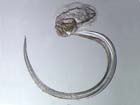Larvaceans (Appendicularians)

The larvaceans or appendicularians are the only group of pelagic tunicates in the Arctic. The larvacean body is tadpole-like. Larvaceans secrete an elaborate external food concentrating filter called a house. The house excludes very large particles, but concentrates partilces as small as bacteria which the animal then sucks in. Houses eventually clog, and are discarded, becoming an important source of marine snow.
Many polar larvaceans are large compared to species in warmer waters, up to 2-3 cm in total length, with houses the size of a chicken egg. Growth is rapid compared to many other groups, and they can be particularly abundant at the ice-edge bloom.
They can be found all the way from the surface to the bottom of the oceans, although most species have a specific range of depth over which they are found. We know little for sure about how long most species live in the Arctic, but it is likely on the order of several months, possibly half a year over the winter.
Five (5) species of larvaceans are known to exist in the subarctic, although O. vanhoeffeni is restricted to the northern Bering Sea.
Page Author: Russ Hopcroft
Created: January 1, 2010









